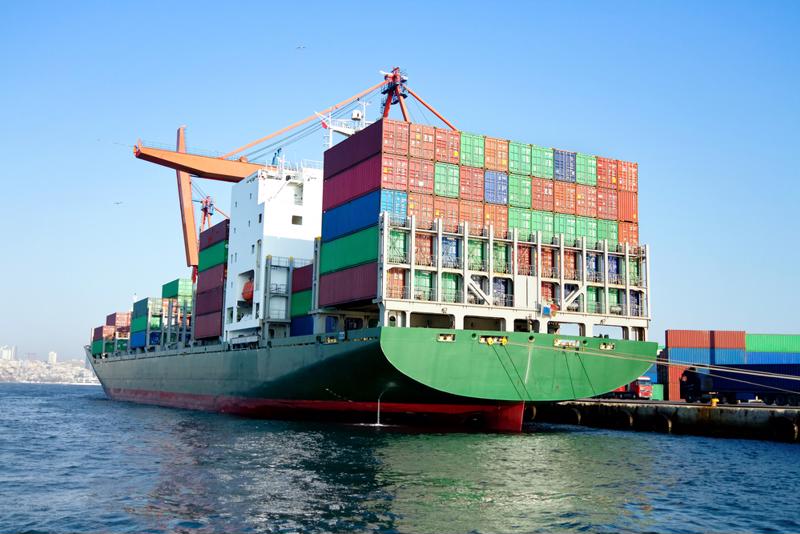As 2014 dragged on the International Longshore and Warehouse Union (ILWU) and the Pacific Maritime Association (PMA) began to toss verbal barbs at each other as their contract negotiations reached an impasse. In late 2015 and early 2016, the collaboration of the two organizations was key to bringing the largest ship to ever call on a North American port to Southern California.
The ILWU-PMA contract dispute of 2014-2015 left a lasting scar on the Pacific Coast. However, the CMA CGM Benjamin Franklin's arrival in Los Angeles was a sign of the healing that has continued since the two organizations came to a tentative contract agreement in 2015, the Journal of Commerce (JOC) reported. The contract dispute between the ILWU and the PMA led to long lines of trucks waiting outside Pacific ports, and similarly extended lines of ships halted offshore. The congestion had a severely adverse effect on West Coast ports and led many shippers to divert their business to the East Coast.
Mega-ships to dock regularly in Southern California
While congestion has persisted to a degree since the two sides came to an agreement, conditions have improved over the lowest points of the extended negotiations between the organizations. Now they, along with ports along the Pacific, are working to bring business back west. The arrival of the Benjamin Franklin in Los Angeles should help with that. The mega-ship has made two calls to the ports of Los Angeles and Long Beach, and CMA CGM will begin weekly trips to the largest port complex in the country.
The Benjamin Franklin has a capacity of 18,000 20-foot equivalent units (TEU), according to the JOC. The six ships that will call upon the ports weekly will have the same capacity. Ships with this sort of capacity have become more popular. With these massive vessels, shippers can move more cargo in a single trip. This has forced facilities around the world to adapt. Many ports are expanding to accommodate these mega-ships and the Panama Canal is being widened to allow larger vessels to pass through. The idea is to lower costs through economies of scale.
 Massive cargo ships have become more popular for efficient movement of goods.
Massive cargo ships have become more popular for efficient movement of goods. Massive ships are considered more efficient
These mega-ships have been docking at ports in Europe and Asia for years now, The Los Angeles Times reported. But they can place a heavy burden on components of the supply chain that were built to handle smaller ships.
"Everything has been built around what the status quo is now, and you're upping the ante here," Jim Blaeser, a maritime analyst at global consulting firm AlixPartner, told the Los Angeles Times.
Pacific trade routes are well-worn, but North American ports have yet to do much business with these mega-ships until now. Los Angeles is a port large enough to justify the amount of a cargo a ship like the Benjamin Franklin can carry, according to the media outlet. This is important because, in the race to construct larger ships that can move more goods using less fuel, the shipping industry ended up flooding with capacity. However, a port as large as Los Angeles will put excess capacity to good use.
Improved ILWU-PMA relations make mega-ships possible
The healing process in Southern California is part of the reason these mega-ships will soon be calling on the Los Angeles-Long Beach facilities regularly. The ILWU and PMA began fixing their fractured relationship by collaborating on a supply chain optimization effort in April 2015, according to the JOC. The initiative consists of regular meetings of port officials to go over possible changes to improve cargo movement efficiency.
Since then, participants have worked to improve cargo velocity in the Los Angeles-Long Beach facilities to ensure that ports recover from the congestion that plagued them during the ILWU-PMA negotiations. Representatives worked to find solutions for chassis shortages, marine terminal production problems and lengthy truck queues at terminal gates. More efficient cargo movement is key to the ports' ability to handle mega-ships such as the Benjamin Franklin. Paul Trani, president of ILWU Local 63, explained that they need open space at the facilities to handle the amount of cargo the mega-ships carry.
"The key is that there is only so much land here. We have to push the cargo out without letting it sit on the terminals," he explained to the JOC.
So far, it seems the ports of Los Angeles and Long Beach have been successful enough at mitigating congestion to accept weekly visitations from mega-ships.